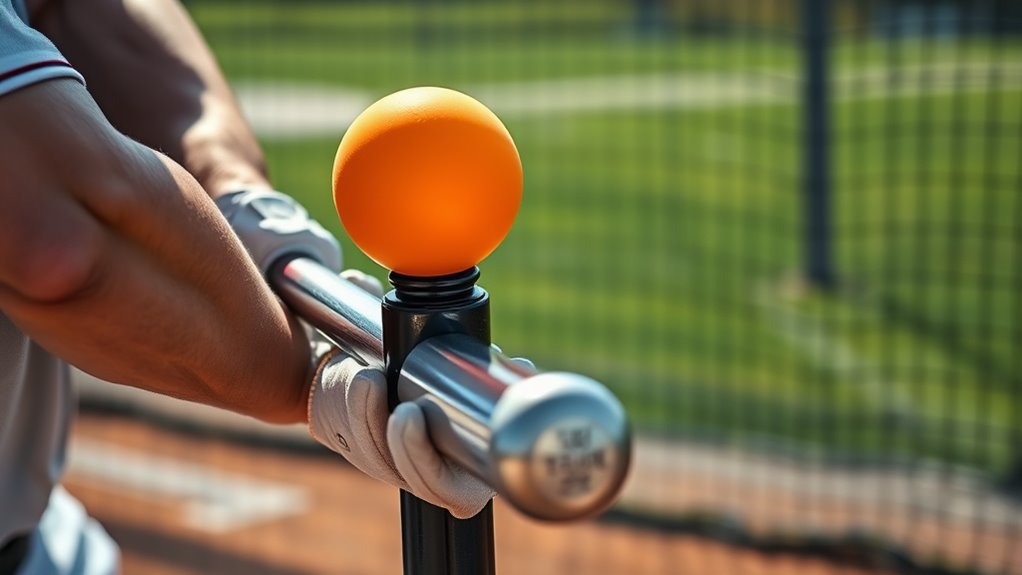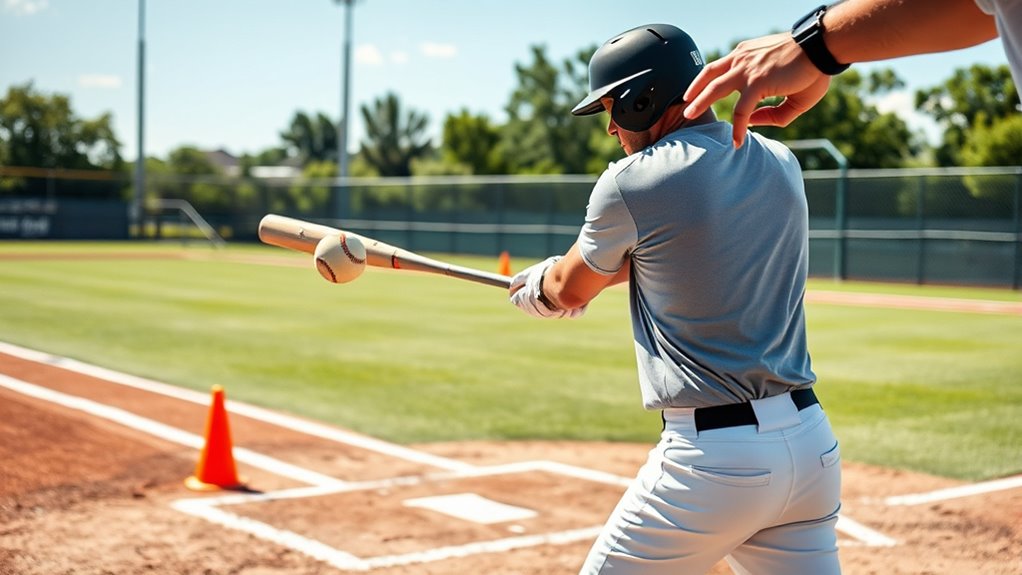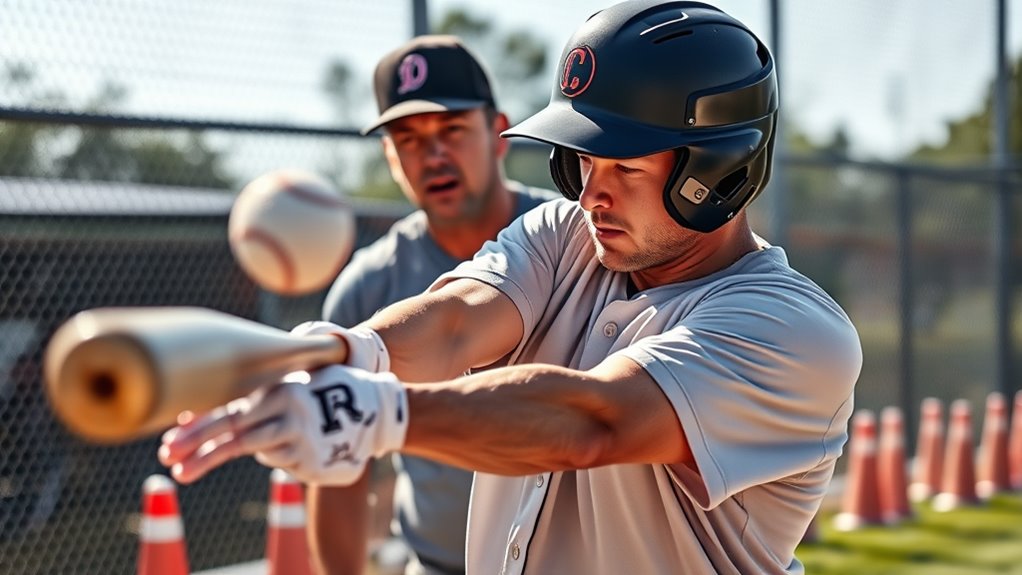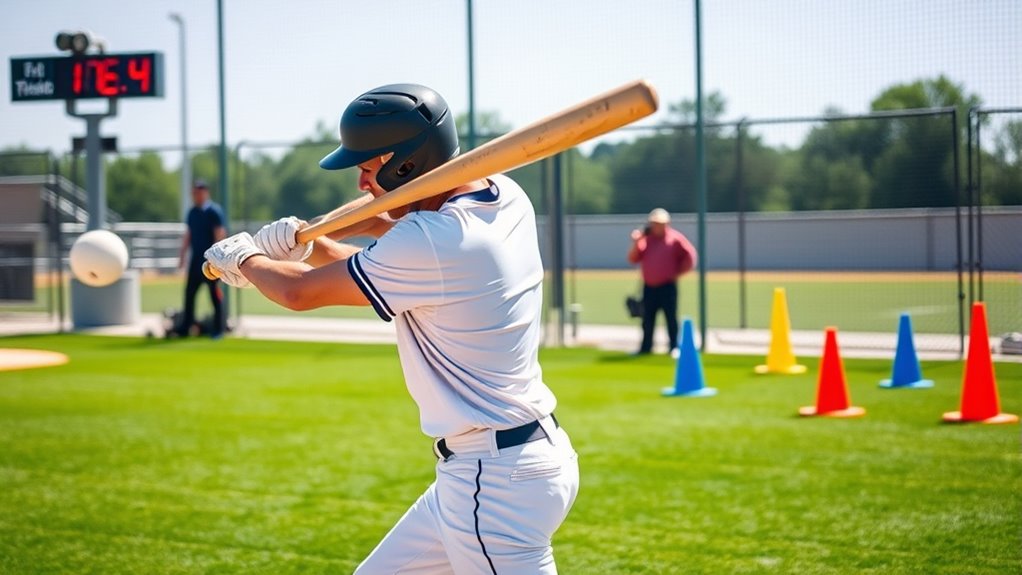To boost your batting average, focus on drills that sharpen hand-eye coordination, swing consistency, and timing. Try soft toss and tee work to develop steady mechanics, then use front toss and wall drills for control and power. Incorporate live pitch simulations to mimic game conditions and short-game drills for contact precision. Improve reaction speed with quickness exercises and analyze your swing with video reviews. Keep practicing, and you’ll uncover more ways to elevate your hitting game.
Key Takeaways
- Incorporate soft toss drills to improve hand-eye coordination and contact consistency.
- Use tee work to develop a steady swing path and reinforce proper mechanics.
- Practice front toss to enhance timing and rhythm for better pitch recognition.
- Include live pitch simulation to build reaction speed and decision-making skills.
- Implement two-strike adjustment drills to improve discipline and resilience at the plate.
Soft Toss Drill for Hand-Eye Coordination

The soft toss drill is a simple yet effective way to improve your hand-eye coordination, which is essential for consistent batting. As you practice, focus on your visual tracking, keeping your eyes on the ball as it approaches. This sharpens your ability to judge speed and trajectory, making your swings more accurate. By repeatedly hitting soft tosses from a partner or a machine, you develop better hand coordination, syncing your eyes and hands for quicker reactions. This drill encourages you to stay relaxed and attentive, sharpening your focus on the ball from the pitcher’s hand to contact. Over time, this improved coordination translates into more consistent hits and increased confidence at the plate. It’s a straightforward exercise that lays a strong foundation for better batting performance. Incorporating proper technique into your practice can further enhance your results.
Tee Work for Swing Consistency

Tee work helps you develop a consistent swing path and solid contact points. By focusing on your stance and making small adjustments, you can improve your overall timing. This drill keeps your mechanics sharp and builds confidence at the plate. Incorporating fundamental techniques into your practice ensures steady improvement and helps prevent bad habits from forming.
Focus on Swing Path
Focusing on your swing path is essential for consistent contact and improving your batting average. When working with a tee, pay close attention to your bat path and how it relates to the swing plane. Your goal is to make sure your bat moves on a smooth, direct line that matches the pitch trajectory. A proper bat path promotes solid contact and helps you avoid common flaws like looping or dipping. Use the tee to visualize and refine this path, feeling how your hands and hips work together. With repeated practice, you’ll develop muscle memory that keeps your swing on the correct plane, leading to more consistent hits and higher averages. Remember, small adjustments in your swing path can make a big difference. Incorporating empathetic coaching techniques can also boost your confidence and enjoyment during practice sessions.
Maintain Proper Stance
Maintaining a proper stance is fundamental for consistent and powerful swings during tee work. Your stance sets the foundation for a solid swing, helping you achieve the right balance position. To do this, keep your feet shoulder-width apart, knees slightly bent, and weight evenly distributed. Stay relaxed and upright, with your hands comfortably below your shoulders. Proper gear shifting, similar to maintaining the right bike setup, ensures smooth performance during your swings. Focus on maintaining this stance throughout your swing to improve swing consistency and power. Your proper stance is the key to hitting success.
Consistent Contact Points
Achieving consistent contact points is essential for developing a reliable and powerful swing. Your batting stance sets the foundation, helping you stay balanced and prepared to make contact. Focus on maintaining proper hand positioning as you approach the ball; this guarantees your hands are in the right spot to meet the pitch efficiently. During tee work, aim to hit the same spot with every swing, reinforcing muscle memory for contact consistency. Adjust your stance slightly if you notice your contact points shifting, and keep your hands relaxed but controlled. By dialing in your hand positioning and stance, you create a repeatable swing path that consistently meets the ball at the same point. This consistency translates into better contact, more solid hits, and ultimately, a higher batting average. Incorporating mindful practice of your stance and grip can significantly enhance your swing reliability.
Front Toss Drill to Improve Timing

In the front toss drill, consistent toss placement helps you time your swing better and develop rhythm. By focusing on when the ball arrives, you can sharpen your reaction and improve your overall timing. This drill keeps you centered on synchronization, making your swings smoother and more accurate. Incorporating protective styling benefits into your practice can also help maintain your hair health during regular training sessions.
Consistent Toss Placement
Consistent toss placement is essential for developing reliable timing and smooth swing mechanics. When your tosses land in the same spot, you build muscle memory that helps you time pitches more accurately. To achieve this, focus on your visual target, aligning your eyes with the ball’s expected path. This sharp focus improves toss accuracy and ensures each ball is delivered consistently. Practice with a controlled, repeatable motion, aiming to keep your tosses steady and precise. By maintaining a consistent toss placement, you train your brain and body to anticipate the ball’s arrival better, leading to more confident swings. Incorporating visual focus techniques can further enhance your toss consistency and overall hitting performance. Over time, this consistency translates into improved timing at the plate, helping you make solid contact more often.
Focused Swing Timing
Focusing on swing timing is essential for making solid contact, and the front toss drill is an effective way to sharpen this skill. To maximize its benefits, incorporate visualization techniques before each hit, imagining the perfect swing and contact point. This mental focus helps you stay present and sharpens your awareness of timing cues. As you practice, pay close attention to the rhythm of your swing, syncing your movements with the toss. Consistently visualizing success boosts your confidence and trains your brain to anticipate pitches more accurately. Over time, this mental discipline improves your timing, making your swings smoother and more controlled. Additionally, understanding the AI security vulnerabilities associated with training tools can help you identify and mitigate potential risks in your practice setup. Use the front toss drill as a foundation to develop a stronger, more focused approach at the plate.
Batting Against a Wall for Control and Power

Batting against a wall is an effective way to develop better control and increase power in your swing. By focusing on bat control, you learn to judge the ball’s placement and timing more accurately. As you hit the wall, the ball’s rebound helps you refine your hand-eye coordination and feel for contact. The wall rebound provides instant feedback, allowing you to adjust your swing path and timing quickly. Consistently practicing this drill helps you develop a smoother, more controlled swing, leading to more solid contact during games. Make sure to vary your target spots on the wall to simulate different pitch locations. Over time, this drill enhances your control and builds power, making your swings more effective at the plate. Developing consistent practice routines is essential for long-term improvement in your swing technique.
Live Pitch Simulation for Game-Like Experience

To prepare for real-game situations, incorporating live pitch simulations into your batting practice is essential. These drills help you refine pitch selection and sharpen mental focus under pressure. By facing pitches that mimic game speed and variety, you learn to read the pitcher’s cues and anticipate ball placement. This simulates actual at-bats, boosting your confidence and reaction time. Use the following table to track key aspects of your live pitch sessions:
| Focus Area | Tips |
|---|---|
| Pitch Selection | Practice recognizing different pitch types early |
| Mental Focus | Stay present and visualize success |
| Reaction Speed | Respond quickly to changing pitch locations |
| Adjustments | Make quick decisions based on pitch reads |
| Consistency | Develop a routine for each simulated at-bat |
Additionally, understanding data integrity and how it relates to analyzing your performance can help you identify areas for improvement and maintain consistency over time.
Two-Strike Adjustment Drills

When facing two strikes, adjusting your approach at the plate becomes vital to avoiding strikeouts and staying alive in the count. Two-strike adjustment drills help you develop mental resilience, enabling you to stay focused under pressure. These drills emphasize pitch recognition, training you to identify the type and location of pitches more quickly, even when the count is against you. By practicing these scenarios, you learn to adopt a more disciplined and selective approach, often aiming to make contact rather than swinging for power. This mental toughness enhances your ability to handle tough at-bats and reduces panic when you’re behind in the count. Ultimately, these drills prepare you to stay composed and make smarter decisions when the stakes are highest.
Short-Game Focus Drills for Contact Precision

Improving your contact accuracy in tight game situations requires focused short-game drills that emphasize precision and control. These drills help sharpen your bat control and pitch recognition, essential for consistent contact. To enhance your skills, try these exercises:
- Practice soft-toss with a focus on hitting low, outside pitches to improve bat control.
- Use a hitting tee to refine swing path and develop muscle memory for precise contact.
- Incorporate timing drills that simulate game-like pitch sequences, sharpening pitch recognition.
- Perform one-handed swings to strengthen control and improve accuracy against challenging pitches.
Reaction Time and Speed Exercises

Enhancing reaction time and speed is crucial for making quick decisions at the plate and reacting effectively to pitches. Your batting stance plays a key role in this, providing a stable base that allows you to adjust swiftly. Incorporate drills that challenge your mental focus, like reaction ball exercises or quick-throw drills, to sharpen your responsiveness. These exercises train your eyes and mind to process information faster, enabling you to recognize pitch types and speeds more quickly. Consistent practice improves your ability to anticipate pitches, reducing hesitation. Stay alert and maintain a focused mindset during each drill. Over time, you’ll notice faster reaction times, better timing, and improved swing decisions, all contributing to a higher batting average.
Video Analysis to Correct Swing Mechanics

Using video analysis allows you to identify and correct flaws in your swing mechanics with clarity and precision. Watching recordings of your swings reveals small misalignments and inefficiencies that are hard to feel. To maximize benefits, focus on these key aspects:
- Stance and Balance: Ensure your feet are properly aligned and balanced at the start.
- Hand and Arm Position: Check that your hands stay inside the ball and your arms stay relaxed.
- Swing Path: Analyze whether your swing follows an ideal, level path through the hitting zone.
- Follow-Through: Confirm that your finish is controlled and consistent, promoting better mechanics.
Regularly reviewing your videos helps develop a clear understanding of swing mechanics, leading to more consistent contact and improved batting averages.
Bat Speed and Power Enhancing Drills

To increase your batting power, you need to focus on improving your swing speed and strength. Incorporate swing speed drills to boost your quickness and reaction time at the plate. Additionally, power weight exercises can help you build the muscle needed for more force behind each swing.
Swing Speed Drills
Increasing your swing speed is essential for hitting the ball harder and farther. To improve bat speed, focus on refining your swing mechanics through targeted drills. Here are four effective swing speed drills:
- Towel Swings: Use a small towel, swinging it smoothly to develop quick, controlled movements.
- Overload/Underload Bat Training: Alternate between heavier and lighter bats to enhance speed and control.
- Swing Fast Drill: Focus on maximum speed without losing form, emphasizing quick shift from load to contact.
- Mirror Work: Practice swings in front of a mirror to monitor and correct your swing mechanics for ideal bat speed.
Consistently practicing these drills will help you generate more bat speed, leading to increased power and distance at the plate.
Power Weight Exercises
Building on your swing speed drills, incorporating power weight exercises can substantially boost both bat speed and overall hitting power. These exercises target muscle endurance, helping you sustain strength through longer at-bats, and improve core stability, which is essential for generating explosive power. Focus on movements like weighted swings, rotational lifts, and medicine ball throws to develop the muscles involved in swinging. Strengthening your core stabilizes your body during each swing, increasing control and power transfer. Consistent training with power weights enhances your ability to generate force quickly, translating into faster bat speed and harder hits. Incorporate these exercises into your routine to see noticeable improvements in your hitting performance and overall batting average.
Frequently Asked Questions
How Often Should I Perform These Hitting Drills for Optimal Improvement?
You should aim for consistent practice frequency to see steady improvement. Performing hitting drills 3 to 4 times a week allows you to develop muscle memory without risking burnout. Drill consistency is key, so focus on maintaining a regular schedule and proper technique. By sticking to this routine, you’ll build strength, improve timing, and elevate your batting average effectively over time.
Can These Drills Be Adapted for Different Age Groups and Skill Levels?
Did you know that adaptable training can improve performance by up to 30%? You’ll find that hitting drills are highly flexible for different age groups and skill levels. With age adaptability and skill customization, you can modify drills to suit beginners or advanced players. This guarantees everyone stays challenged and progresses at their own pace. So, yes, these drills are easy to tailor, making them effective for all ages and abilities.
What Equipment Is Essential to Effectively Execute Each Drill?
To effectively execute each hitting drill, you need essential equipment like batting gloves to improve grip and control. Training aids such as tee setups, soft toss nets, and bat sensors can enhance your practice sessions. Make sure you select equipment suited to your skill level and age. Using the right gear helps you stay safe, develop proper technique, and get the most out of each drill, ultimately boosting your batting performance.
How Do I Track Progress and Measure Improvement Over Time?
Like a compass guiding your journey, tracking progress keeps you oriented. Use progress journaling to record each practice, noting improvements and setbacks. Set clear performance benchmarks, such as consistent contact or swing speed, to measure growth over time. By regularly reviewing your journal and benchmarks, you’ll see your skills evolve, turning raw effort into mastery. This ongoing reflection fuels motivation and sharpens your focus on becoming a better hitter.
Are There Common Mistakes to Avoid During These Batting Drills?
When doing batting drills, be aware of common pitfalls like neglecting proper technique or rushing your swings. These mistakes hinder progress and make technique correction more difficult. Focus on maintaining proper stance, controlling your swing, and staying relaxed. Avoid overtraining or practicing with poor form, as these can reinforce bad habits. Consistently review your technique, seek feedback, and correct mistakes early to develop better habits and improve your batting performance.
Conclusion
By consistently practicing these drills, you’ll notice improvements in your swing, timing, and overall confidence at the plate. Sometimes, the smallest adjustments—like a better eye or quicker reaction—can unexpectedly lead to game-changing hits. Remember, progress often comes when you least expect it, blending your hard work with a bit of luck. Stay patient, keep honing your skills, and you’ll find that success often arrives when you’re least looking for it.









